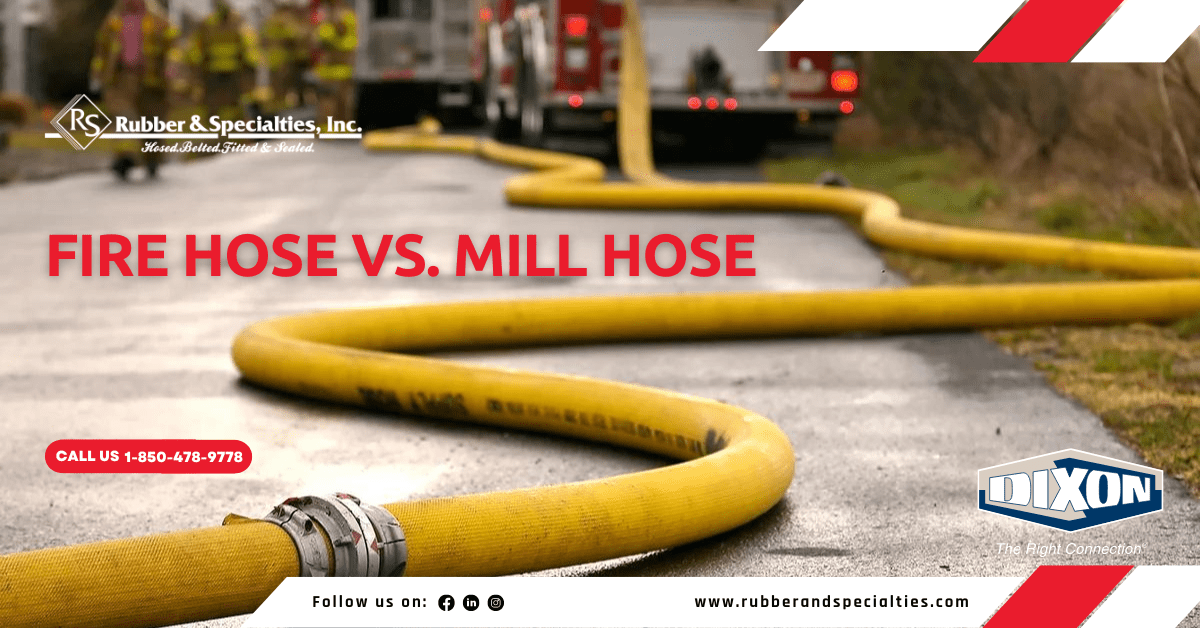
Fire Hose vs. Mill Hose
Just like there are different types of fire hose nozzles and fire department connections, there are also different types of hoses. While it may seem like all hoses are the same since they can all distribute water, some hoses are designed for various purposes and are not always acceptable for fighting fires. Knowing how a hose will be used is critical in selecting the correct hose for the application. That’s why it is important to understand the components of a hose and the difference between fire and mill hose.
Hose Components
Hoses are composed of the inner lining and outer jacket. The inner lining is a single ply of ethylene propylene diene monomer (EPDM) rubber. This lining is durable and chemical-resistant, but it will not hold fluid pressure. The inner lining is inserted and pulled through the outer jacket, and steam vulcanization is used to bond the jacket to the lining.
The outer jacket of hoses made of ring-spun polyester yarns are engineered to resist abrasion, mold, and mildew. The jacket gives the hose strength, is available in a variety of colors depending on the type of hose, and can feature a single or double jacket.
Single vs. Double Jacket Hose
Every hose has a rubber liner or tube that holds the water in the hose. The jacket is a protective cover around the tube. Fire hose and mill hose can be classified as single or double jacket. Single jacket hose has one cover protecting the inner lining while double jacket hose has two layers of covering.
Hose Threads
Hoses typically have a fitting on the end. This fitting has threads. It is important to note that the fitting threads do not seal the connection, but rather hold the fittings together. Fittings seal at the gasket to prevent leaks.
Most fire hoses come with National Hose (NH), National Standard Thread (NST), or National Pipe Straight Hose (NPSH) threads. The most common thread type used by fire departments is NST, often referred to as fire hose thread. The importance of having the correct threads for the application cannot be understated. The Baltimore fire of 1904 is a perfect example. Read our Threads 101 blog post to learn more about that fire and the importance of properly matching threads.
Fire Hose
Fire hose is used to convey water or another fire retardant, such as foam, to help eliminate a fire. When distributing water, an open water supply or pressurized water supply can be used. When used outdoors, the fire hose attaches to either a fire engine or a fire hydrant. Indoors, the hose attaches to a building’s standpipe or plumbing system.
Mill Hose
Mill hose is the term used to describe the type of hose used in applications that do not involve fighting fire. Mill hose differs from garden hose because it is constructed differently to withstand more water pressure and harsh environments while still being easy to handle. Mill hose is more economically produced than fire hose, but it is not tested, nor is it FM approved or UL listed, for fire fighting or hydrant and sprinkler system flow testing.
Single Jacket Fire Hose
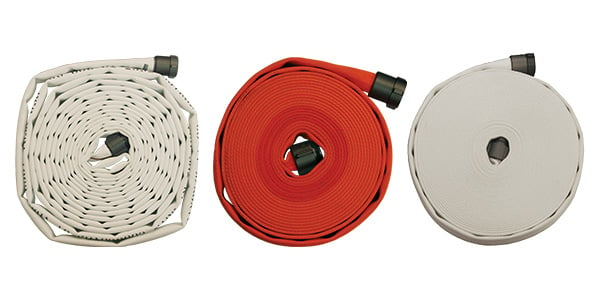
Single jacket fire hose is designed for occasional light use with one woven polyester jacket bonded to the outside of the EPDM rubber liner. This type of hose can reduce costs and weight. Single jacket fire hoses can be coupled with female and male expansion rings or uncoupled. Aluminum and brass couplings are available, as are assorted sizes and lengths of coupled and uncoupled hose. The maximum working pressure of 500# single jacket fire hose is 225 PSI at 70°F (21°C) and 135 PSI at ambient temperature for 300# single jacket fire hose.
Double Jacket Fire Hose
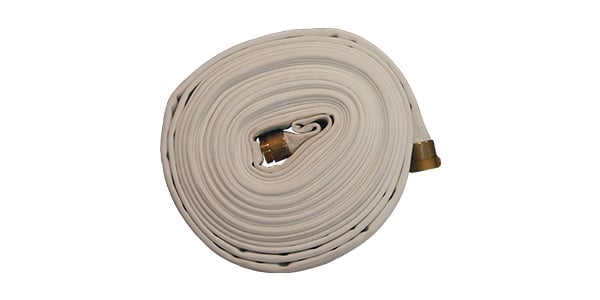
Double jacket fire hose adds durability and strength to single jacket hose with an additional woven polyester jacket. This type of hose is used by fire departments for fire attack and in heavy industrial applications. Although a double jacket hose is more costly than a single jacket, there is also the added benefit of a longer service life. Double jacket fire hose also has a greater maximum working pressure of 360 PSI at 70°F (21°C). The hose is coupled with aluminum or brass male and female expansion rings. The size and length of the hose vary depending on your needs.
Non-Collapsible Fire and Utility Hose
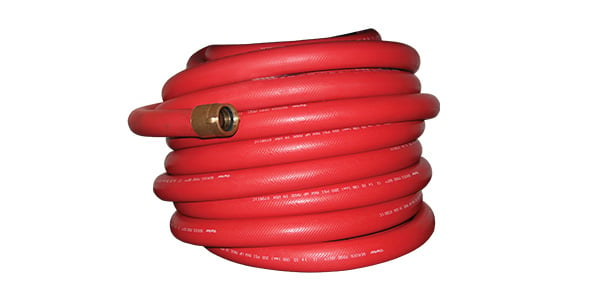
Non-collapsible fire hose is flexible and usually located on a reel on a fire truck or smaller fire utility vehicle to fight small fires. The red hose, available in 1-1/2″ diameter only and in lengths of 50′ and 100′, is coupled with rocker lug or expansion ring couplers. The fittings are available in brass and chrome brass. The maximum working pressure is 200 PSI at 70°F (21°C).
Forestry Fire Hose Non-Weeping
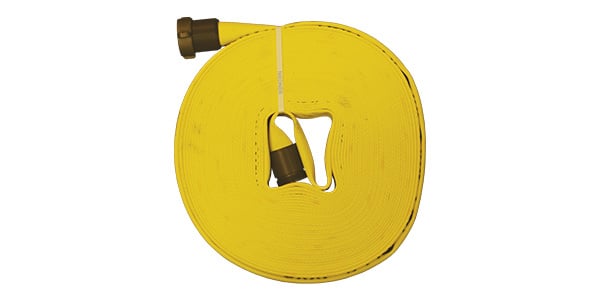
Forestry fire hose is typically lighter and more portable than traditional fire hoses, making them easier for firefighters to maneuver through rugged terrain. The hose is made of a polyester single jacket coupled with expansion ring couplings, and the tube is constructed of thermoplastic. One advantage of this forestry fire hose is it is non-weeping, meaning the hose will not discolor. It also conserves water which is critical where the water supply may be limited. Available in 1″ and 1-1/2″ sizes and 50′ and 100′ lengths with a maximum working pressure of 270 PSI at 70°F (21°C).
Rack Hose
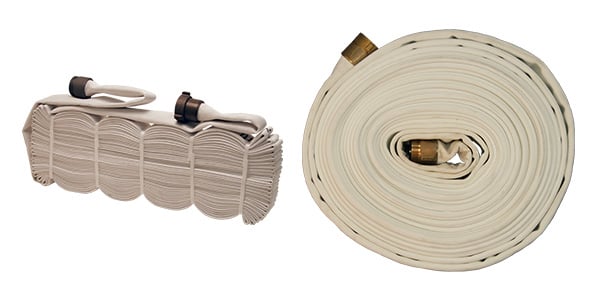
Rack hose is used for pin rack service and emergency fire fighting only. It should not be used for washdown. The single jacket, polyester hose is frequently used at hotels, warehouses, hospitals, airports, municipal, and public buildings. The non-UL labeled rack hose has a maximum working pressure of 225 PSI at 70°F (21°C). The UL-labeled rack hose has a maximum working pressure of 135 PSI at ambient temperature. The hose is coupled with male and female expansion ring couplings. Both the UL-labeled and non-UL-labeled rack hose are only available in 1-1/2″ sizes and lengths of 50’’ and 100′.
MSHA-Approved Mine Fire Hose
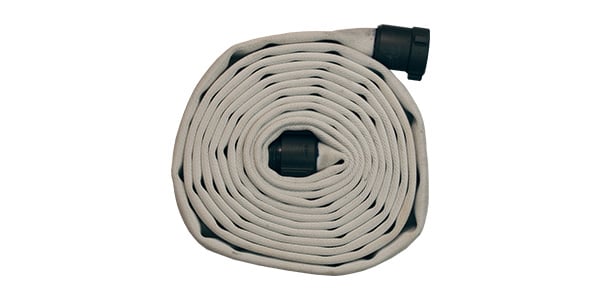
As indicated in the name, this hose is approved by the Mine Safety and Health Administration (MSHA) for all mine fire protection applications. The outer body is constructed of a white, single jacket, synthetic, flame-resistant material. The tube features a flame-resistant lining that does not produce toxic gases when ignited. The MSHA-approved mine fire hose is only available in 50′ length, 1-1/2″ diameter, and has a maximum working pressure of 225 PSI at 70°F (21°C). The hose can be coupled with male and female aluminum rocker lug expansion ring couplings.
Potable Water Hose
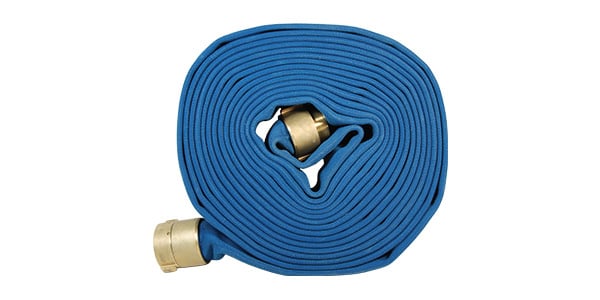
Color-coded blue for water use, potable water hose is a double jacket, all polyester hose with thermoplastic tubing. The liner is NSF-approved for potable water, but the fittings are not, except for temporary/emergency drinking needs only. The hose is coupled with brass or aluminum rocker lug expansion rings and is available with NPSH, NST, or NH threads. Potable water hose comes in 1-1/2″ and 2-1/2″ diameters in lengths for 50’ and 100’. The maximum working pressure is 270 PSI at 70°F (21°C).
Nitrile Washdown Hose
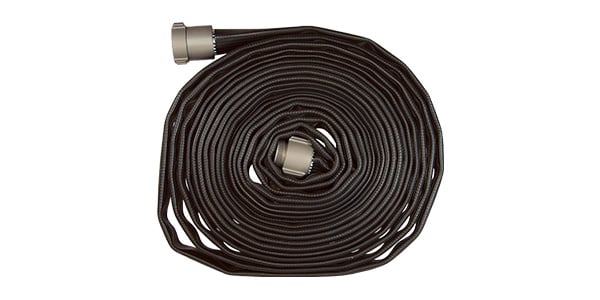
Ideal for industrial, agricultural, and construction washdown and discharge applications, Dixon’s nitrile washdown hose features a tough nitrile construction for resistance to weather and abrasion. This hose is not intended to be used for firefighting. The nitrile washdown hose comes in a variety of sizes ranging from 1″ to 6″. The coupling options include aluminum expansion ring couplings, short shank couplings, a crimp sleeve, aluminum shank with a brass pin lug swivel nut, cam & groove couplings, or the hose can be uncoupled. The maximum working pressure depends on the size of the hose. 1″ to 2-1/2″ hoses have a maximum working pressure of 200 PSI, while 3″-6″ hoses have a maximum working pressure of 150 PSI.
Synthetic Single Jacket Mill Hose
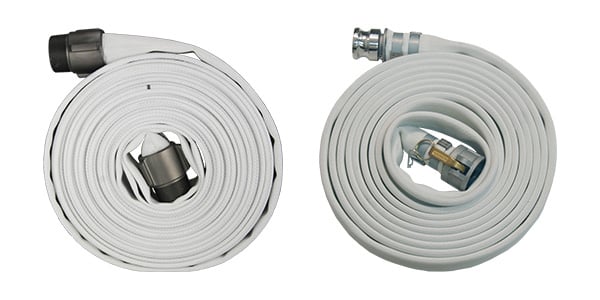
Synthetic single jacket mill hose is used in open-end water discharge applications only. These applications include construction site dewatering, parks, crop watering, pond draining, water transfer, dust control, water spraying, and pump discharge. Mill discharge hose should not be used for drinking water or compressed air, and is not intended for fire fighting service. The tube is constructed of black, PVC rubber. All common sizes and lengths are available. The working pressure of a synthetic single jacket mill hose depends on whether or not the hose is coupled, what type of coupling is used, and the size of the hose. View our catalog to learn more.
Synthetic Double Jacket Mill Hose
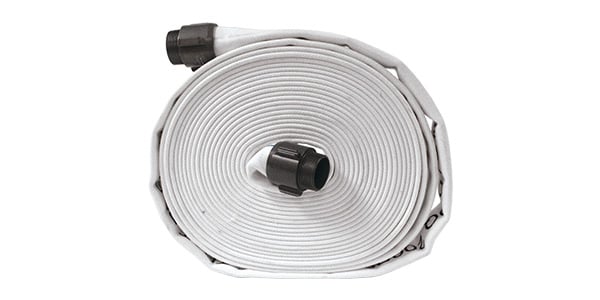
Synthetic double jacket mill hose is similar to synthetic single jacket mill hose, with the obvious difference of having two jackets instead of one. Double jacket hoses are not recommended for use with field re-attachable couplings. The working pressure is 200 PSI at 70°F (21°C). The double jacket mill hose is available in 1-1/2″ to 2-1/2″ sizes, 50′ and 100′ lengths, and can be uncoupled or coupled with rocker lug aluminum expansion rings, or a global cam & groove coupling and crimp sleeve.
Summary
Hoses may serve the same general purpose, but the type of hose used in an application matters. Mill hose should not be used in firefighting scenarios, and there is no need to use a fire hose when mill hose is better suited for the job. Understanding the difference between the two is imperative.

